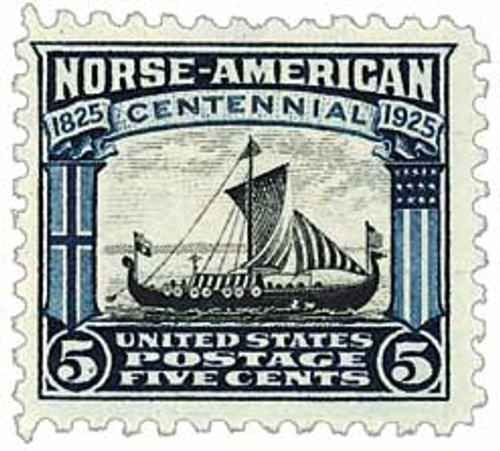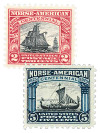
# 620-21 - Complete Set, 1925 Norse-American Issue, 2 Stamps
U.S. #620-21
1925 Norse-American Centennial
• First two-color commemoratives since the 1901 Pan-American Series
• Commemorates the arrival of the first Norwegian immigrants to America
• Publicized the 1925 Norse-American Centennial
Stamp Category: Commemorative
Set: Norse-American Centennial
Value: 2¢ and 5¢ stamps
First Day of Issue: May 18, 1925
First Day City: Algona, IA; Benson, MN; Northfield, MN; Decorah, IA; Minneapolis, MN; St. Paul, MN; Washington, DC
Quantity Issued: 9,104,983 (2¢) and 1,900,983 (5¢)
Printed by: Bureau of Engraving and Printing
Printing Method: Flat Plate
Format: Sheets of 100 (10 x 10), with selvage on four sides
Perforations: 11
Color: Carmine and black (2¢) and dark blue and black (5¢)
Why the stamps were issued: To publicize the June 6-9, 1925, Norse-American Centennial celebration held at the Minnesota State Fair and to commemorate the October 9, 1825, arrival of the first Norwegian immigrants to America.
About the stamp designs: The central design of the 2¢ stamp pictures the ship Restaurationen as it would’ve looked in 1825. The artist used a painting of its sister ship as a reference as no surviving images existed of the Restaurationen. There is a second ship in the background on the right side of the stamp. The top of the stamp design includes “Norse-American” and “1825-1925 Centennial.” Either side of the design pictures a dragon from the prow of a Viking longship with a Viking shield under the dragon.
The 5¢ stamp shows a Viking ship based on an 1893 photograph from the Columbian World’s Fair. The Viking ship was built in Norway in 1893 and sailed across the Atlantic and Great Lakes to Chicago for the fair. The ship was 76 feet long with one small sail and a dragons head and tail at the front and back of the ship, respectively. Each side of the stamp has a vertical banner, a Norwegian flag on the left and US flag on the right. The top of the design includes “Norse-American” and “1825-1925 Centennial.”
Why definitive size? It’s unusual for commemoratives to be definitive-sized and be printed in sheets of 100 with selvage on four sides. These stamps have no straight-edges, also unusual for commemoratives in the 1920s.
First Day City: The First Day Cities were in areas near the Norse-American Centennial celebration at the Minnesota State Fair June 6-9, 1925, and areas with many Norse-Americans. All stamps of this era also had Washington, DC, First Day Cancels.
History the stamps represent: The first Norwegian immigrants arrived in New York City Harbor on October 9, 1825. They traveled her aboard the ship Restaurationen, shown on the 2¢ stamp. After three months at sea, 52 people arrived in America. However, the relatively small ship (54 feet long by 16 feet wide) had more passengers than allowed by the 1819 Passenger Act. The US impounded the ship, arrested the captain, and imposed a stiff fine. Thankfully, on November 15, 1825, President John Quincy Adams freed the captain, rescinded the fine, and released the ship.
October 9th, the day the Norwegians arrived, is celebrated in the United States as Leif Erikson Day. The Norse explorer is believed to have been the first European to reach North America. (Erikson was later honored on a 6¢ commemorative stamp issued in 1968 – US #1359.)
U.S. #620-21
1925 Norse-American Centennial
• First two-color commemoratives since the 1901 Pan-American Series
• Commemorates the arrival of the first Norwegian immigrants to America
• Publicized the 1925 Norse-American Centennial
Stamp Category: Commemorative
Set: Norse-American Centennial
Value: 2¢ and 5¢ stamps
First Day of Issue: May 18, 1925
First Day City: Algona, IA; Benson, MN; Northfield, MN; Decorah, IA; Minneapolis, MN; St. Paul, MN; Washington, DC
Quantity Issued: 9,104,983 (2¢) and 1,900,983 (5¢)
Printed by: Bureau of Engraving and Printing
Printing Method: Flat Plate
Format: Sheets of 100 (10 x 10), with selvage on four sides
Perforations: 11
Color: Carmine and black (2¢) and dark blue and black (5¢)
Why the stamps were issued: To publicize the June 6-9, 1925, Norse-American Centennial celebration held at the Minnesota State Fair and to commemorate the October 9, 1825, arrival of the first Norwegian immigrants to America.
About the stamp designs: The central design of the 2¢ stamp pictures the ship Restaurationen as it would’ve looked in 1825. The artist used a painting of its sister ship as a reference as no surviving images existed of the Restaurationen. There is a second ship in the background on the right side of the stamp. The top of the stamp design includes “Norse-American” and “1825-1925 Centennial.” Either side of the design pictures a dragon from the prow of a Viking longship with a Viking shield under the dragon.
The 5¢ stamp shows a Viking ship based on an 1893 photograph from the Columbian World’s Fair. The Viking ship was built in Norway in 1893 and sailed across the Atlantic and Great Lakes to Chicago for the fair. The ship was 76 feet long with one small sail and a dragons head and tail at the front and back of the ship, respectively. Each side of the stamp has a vertical banner, a Norwegian flag on the left and US flag on the right. The top of the design includes “Norse-American” and “1825-1925 Centennial.”
Why definitive size? It’s unusual for commemoratives to be definitive-sized and be printed in sheets of 100 with selvage on four sides. These stamps have no straight-edges, also unusual for commemoratives in the 1920s.
First Day City: The First Day Cities were in areas near the Norse-American Centennial celebration at the Minnesota State Fair June 6-9, 1925, and areas with many Norse-Americans. All stamps of this era also had Washington, DC, First Day Cancels.
History the stamps represent: The first Norwegian immigrants arrived in New York City Harbor on October 9, 1825. They traveled her aboard the ship Restaurationen, shown on the 2¢ stamp. After three months at sea, 52 people arrived in America. However, the relatively small ship (54 feet long by 16 feet wide) had more passengers than allowed by the 1819 Passenger Act. The US impounded the ship, arrested the captain, and imposed a stiff fine. Thankfully, on November 15, 1825, President John Quincy Adams freed the captain, rescinded the fine, and released the ship.
October 9th, the day the Norwegians arrived, is celebrated in the United States as Leif Erikson Day. The Norse explorer is believed to have been the first European to reach North America. (Erikson was later honored on a 6¢ commemorative stamp issued in 1968 – US #1359.)







